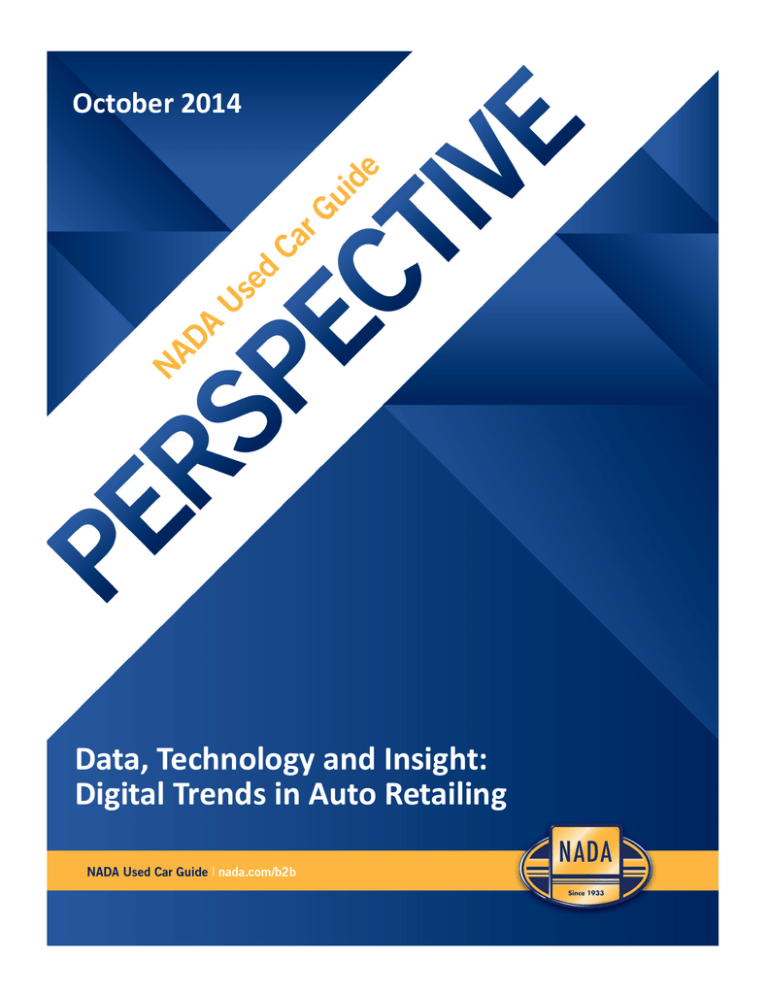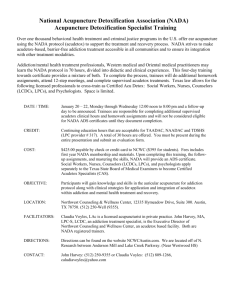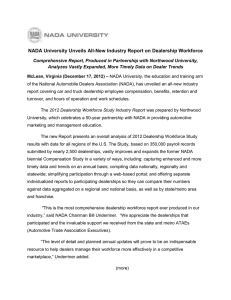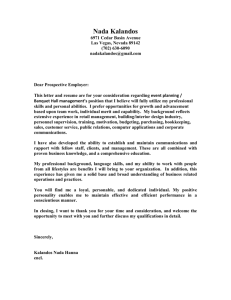Data, Technology and Insight: Digital Trends in Auto
advertisement

October 2014 Data, Technology and Insight: Digital Trends in Auto Retailing Perspective | October 2014 TABLE OF CONTENTS Introduction ................................................................................................................................. 2 Auto Shopping in the Past ........................................................................................................... 3 Auto Shopping Today ................................................................................................................... 5 A Modern Approach to Pricing .................................................................................................... 7 Conclusion .................................................................................................................................... 9 References ................................................................................................................................... 10 At NADA Used Car Guide ............................................................................................................. 11 Data, Technology and Insight: Digital Trends in Auto Retailing In March 1989, British computer scientist Tim Berners-Lee drafted a document concerning the difficulties of accessing and managing information stored on individual computers at his then-employer, the European Organization for Nuclear Research (CERN). To address the problem, he proposed linking information systems with hypertext to “allow a pool of information to develop which could grow and evolve with the organisation and the projects it describes.” Berner-Lee’s ideas laid the foundation for what would eventually become the World Wide Web (WWW), or the method of connecting documents (i.e., web pages) to one another using the Internet*. Over the past quarter century, the Internet has thoroughly transformed how consumers and businesses interact with one another by removing physical constraints and providing access to an exceptional depth and breadth of information. Consumers now know more than ever about the products they buy, where to buy them and how much to pay. This knowledge presents many challenges and opportunities for businesses, including franchised automobile dealers. However, the Internet has also provided vast amounts of quantifiable data on consumer purchase behavior that dealers are using to direct strategy toward developing stronger relationships with consumers. *The World Wide Web and the Internet are, in fact, two distinct entities. The Internet is a network of interconnected computers where information resides, while the WWW is the system of interconnected web pages that allow access to stored information. NADA Used Car Guide | 8400 Westpark Drive | McLean, VA 22102 | 800.544.6232 | nada.com/b2b 2 © 2014 NADA Used Car Guide Perspective | October 2014 NADA’s latest edition of Perspective brings together internal analysis and insight from industry-leading information providers such as J.D. Power, Polk, AutoTrader.com and Google to explore how the Internet has shaped consumer and dealer engagement, and the critical roles that technology and price transparency are playing in used vehicle operations today. Auto Shopping in the Past Limited choices influenced by a small sphere Before the Internet, consumer consideration for a new or used automobile was based on a limited number of influencing factors: previous brand experience (likely supported by family and friends), traditional media (TV, newspaper and radio) and local dealership experiences. Dealerships were, by and large, the only source for information on specific models, trim levels and optional equipment, as conveyed through a combination of printed brochures and dealership personnel. The vehicle ultimately purchased was usually among those initially considered, due in part to the inconvenience of driving from dealer to dealer to gather information on a wider variety of alternatives. The price paid for the vehicle was also impacted by the consumer’s willingness to travel from one dealership to another to compare prices, as well as their desire and ability to negotiate with the salesperson. This type of shopping process is commonly referred to as a “purchase funnel,” a metaphor suggesting a linear path that begins with numerous brands under consideration and ends with a specific vehicle. Once a purchase was made, the evaluation of competing products generally ceased, and the focus was isolated to the product that was bought. Source: McKinsey & Company NADA Used Car Guide | 8400 Westpark Drive | McLean, VA 22102 | 800.544.6232 | nada.com/b2b 3 © 2014 NADA Used Car Guide Perspective | October 2014 Digital expands choice and broadens knowledge The rise of the Internet, however, quickly changed all of this. Research has shown that today’s better-informed buyer starts with a much smaller consideration set and then adds and subtracts from it throughout the evaluation phase using a wide variety of online touch points before settling on a vehicle to buy. Postpurchase, consumers share their experiences and absorb those of others, and these opinions play a large role in shaping what they buy in the future. Today's "Consumer Decision Journey" Source: McKinsey & Company Changes in the auto shopping process demonstrate how the digital age has transformed purchase habits. Manufacturer, dealer and third-party websites initially focused on new vehicles and gave consumers the means to easily and efficiently cross-shop numerous brands and segments from the comforts of home. Shoppers were able to build vehicles based on desired colors and optional equipment. Most importantly, the Internet exposed dealer invoice prices and Manufacturer Suggested Retail Prices (MSRPs) on a wide scale. Referral services helped consumers reach an even broader range of dealers via email. Eventually, used vehicle information gained similar exposure, as online listing sites such as AutoTrader.com and Cars.com allowed buyers to compare dealer asking prices within their local area and assess vehicle condition by viewing multiple photos. Consumers could also access used vehicle trade-in and retail values online from sources such as NADAguides.com, further adding to the number of data points available to them. NADA Used Car Guide | 8400 Westpark Drive | McLean, VA 22102 | 800.544.6232 | nada.com/b2b 4 © 2014 NADA Used Car Guide Perspective | October 2014 Auto Shopping Today Majority of buyers use the Internet to shop The J.D. Power 2013 New Autoshopper Study revealed that nearly 80% of new vehicle buyers used the Internet to assist with the shopping process in 2013, up 26 percentage points from 2000’s figure of 54%*. Additional information gathered through the study emphasized the Internet’s impact on consumers’ ability to cross-shop. Specifically, 50% of buyers were initially open to any brand and only 43% of buyers purchased the make or model they initially considered. Research consistently shows that consumers spend considerably more time looking for a new or used vehicle online than offline. For example, the 2013 Polk/AutoTrader.com Automotive Buyer Influence Study revealed that new and used vehicle shoppers spent an average of 10 and 11.75 hours, respectively, online during the car buying process. In contrast, new and used buyers spent averages of 3.75 and 3.5 hours, respectively, shopping offline. Dealer contact has gone virtual While estimates differ across sources, many agree that the increased amount of time spent online means that consumers visit fewer dealerships to acquire the basic information necessary to support a purchase. A survey by DMEautomotive found that 71% and 62% of new and used vehicle buyers, respectively, visited no more than two dealerships before buying. Similarly, AutoTrader.com’s 2012 Have Internet Will Travel report stated that 58% of car buyers visited just one to two dealerships before making a purchase. That’s not to say that consumers are no longer reliant on dealers to provide information — much of the gathering process has simply shifted to the virtual world. In fact, dealer sites were ranked ahead of manufacturer sites, search engines and third-party sites as the number-one source of information for consumers during the shopping process in a Google research study titled Digital Drives Auto Shopping. And while dealership visits have become less frequent, they haven’t become less important, as consumers in the Google study ranked “dealer visit, test drive, and salesperson” well above “family and friends” as the primary in-person sources of information most influential in determining what to purchase. Numerous other studies have drawn similar conclusions. *J.D. Power and Associates. (2011). Online Auto Shoppers: Who Are They and How Do You Meet Their Needs. http://autos.jdpower.com/content/white-paper/PZtzGWd/online-auto-shoppers-who-are-theyand-how-do-you-meet-their-needs.htm NADA Used Car Guide | 8400 Westpark Drive | McLean, VA 22102 | 800.544.6232 | nada.com/b2b 5 © 2014 NADA Used Car Guide Perspective | October 2014 Most Influential Auto Shopping Information Sources Test drive Dealer visit Salesperson Family & Friends 89% 89% 59% Dealer sites Manufacturer Sites Search engines Third party sites Professional review sites Consumer review sites Regional dealer sites Online mapping tools Classified/listing sites Social media Video sites Newspaper sites Auction sites TV Newspapers Magazines Flyers & brochures Radio In Person 82% 83% 81% 77% 69% 62% 57% 56% 43% 40% 37% 37% Online 32% 26% 53% 38% 35% Offline 27% 19% Source: Google "Digital Drives Auto Shopping" Study, November 2013 Mobile technology is expanding the Internet’s influence The J.D. Power 2013 New Autoshopper Study shows that the percentage of automotive Internet users (AIUs) shopping for new vehicles on smartphones and tablets reached 23% and 25%, respectively, in 2013, up 3 and 7 percentage points from 2012 levels. Figures for younger Generation Y shoppers were much higher in these areas, with 47% reporting using smartphones and 29% using tablets when shopping. At 96%, nearly all shoppers surveyed reported using PCs (desktops or laptops). However, this was 3 ppts lower than what was recorded in 2012. Of particular interest to dealers, 46% of Gen Y and 40% of non-Gen Y AIUs reported accessing vehicle content on their smartphone at the dealership, both second only to inhome use. In addition, vehicle pricing was the number-one type of content accessed for both groups while at the dealership, with an overwhelming 65% of tablet and smartphone shoppers reporting this activity. Putting the last statistic in context, mobile technology further empowers consumers by letting them compare prices while engaging a dealer in the showroom. Considering the rapidly expanding use of smartphones, the Internet will continue to wield considerable clout in shaping vehicle pricing moving forward. NADA Used Car Guide | 8400 Westpark Drive | McLean, VA 22102 | 800.544.6232 | nada.com/b2b 6 © 2014 NADA Used Car Guide Perspective | October 2014 A Modern Approach to Pricing Shoppers today routinely access used vehicle retail and trade-in prices from a variety of sources and use them as benchmarks when negotiating with dealers. Similarly, dealer pricing decisions have also improved through advances in technology and increased exposure to, and consumption of, market data. In the past, dealers relied on guidebooks, newspaper ads, printed auction post-sale reports, wholesaler offers and qualitative experience to determine used wholesale (including trade-in) and retail prices. The decision-making process was time-consuming and increased the likelihood that a dealer would either over- or underprice a given vehicle. Today’s dealer accesses pricing data derived from thousands of actual sales transactions, with data delivered through applications that facilitate efficient, educated pricing and inventory management decisions. These robust solutions give dealers far greater insight into the makes and models that have proven to be most desirable in their local market and most profitable at their specific dealership. Information available from auto auctions has also become more widespread. Auction groups such as Manheim, Adesa and ServNet have invested heavily in online platforms that include photos, videos and detailed condition reports, allowing dealers to bid confidently on vehicles located anywhere and at any time. Narrower used listing price spreads, but healthier margins NADA’s analysis of wholesale auction prices and online listing prices reveals that the widespread availability of data has had a major impact on pricing strategy in the used vehicle market. In 2008, the average spread between the price paid at auction and the retail listing price for a given vehicle was approximately $5,000. Since then, however, the spread between the two has steadily decreased and now stands at roughly $4,000. Not only have wholesale-to-asking price spreads decreased, but so too has the variability around average listing prices. In 2008 for example, dealers listed similar vehicles with like-mileage (e.g. a single 2007 Toyota Camry LE versus all 2007 Camry LEs) at prices that varied by 10% from the overall average — a roughly $3,000 high-to-low spread. This variation now stands at 8%. While the 2-percentage point drop may seem small, it is in fact significant given the variability associated with other factors such as vehicle condition. A quick glance at this information may lead one to think that used vehicle profitability has fallen, with dealers having lost about $1,000 of their margin since 2008. This isn’t NADA Used Car Guide | 8400 Westpark Drive | McLean, VA 22102 | 800.544.6232 | nada.com/b2b 7 © 2014 NADA Used Car Guide Perspective | October 2014 Average Wholesale Auction-to-Retail Listing Price Spread $6,000 $5,500 Average Spread $5,000 $4,500 $4,000 $3,500 $3,000 $2,500 Jan-14 Apr-14 Jul-13 Oct-13 Apr-13 Jan-13 Jul-12 Oct-12 Jan-12 Apr-12 Jul-11 Oct-11 Jan-11 Apr-11 Jul-10 Oct-10 Jan-10 Apr-10 Jul-09 Oct-09 Jan-09 Apr-09 Jul-08 Oct-08 Jan-08 Apr-08 $2,000 Period Source: NADA Used Ca r Guide the case, however. Dealership data collected by NADA shows that following decades of declines, gross profit margins on used vehicles finally began to inch up with the advent of the digital age in the mid-2000s. Used vehicle margins have improved markedly since, growing from an average of 11.4% prior to the recession to 13% today, which is among the highest they’ve been in nearly 25 years. Simply put, the insight gained through technology and data has led to healthier used vehicle profit margins, despite the fact that dealers are operating in a more competitive pricing environment. Used Vehicle Gross Profit as a Percentage of Selling Price 2014 data through June. 16.0% 15.0% Gross as a % of Selling Price 14.0% 13.0% 12.0% 11.0% 10.0% 9.0% 1978 1979 1980 1981 1982 1983 1984 1985 1986 1987 1988 1989 1990 1991 1992 1993 1994 1995 1996 1997 1998 1999 2000 2001 2002 2003 2004 2005 2006 2007 2008 2009 2010 2011 2012 2013 2014 YTD 8.0% Source: NADA Calendar Year NADA Used Car Guide | 8400 Westpark Drive | McLean, VA 22102 | 800.544.6232 | nada.com/b2b 8 © 2014 NADA Used Car Guide Perspective | October 2014 Conclusion The digital age has exponentially increased access to information and shattered longstanding knowledge barriers. YouTube provides a perfect example of this. With a few keystrokes and clicks of the mouse, anyone can find videos with detailed answers to questions on virtually any topic, no matter how obscure. Pricing data for autos is similarly widespread. Whether at home or on a dealer’s lot, the Internet allows consumers to quickly hone in on a range of prices indicative of their market. But rather than perceiving empowered consumers as a threat, dealers are embracing this real-world reality and using it to their advantage. Leveraging the knowledge that they too have gained through data and technology, dealers are increasingly adopting a market-based approach to pricing, which they share with consumers through price comparison tools on their web sites and in real-time pricing reports at the sales desk. This transparent approach reduces the friction associated with the most painful part of the car buying process, price negotiation, and in turn fosters the key to future loyalty – trust. Alongside pricing transparency, technology-driven conveniences like tablets in the showroom, online chat, product videos, and text message service reminders are helping dealers to develop stronger, more lasting connections with consumers. Dealers are also investing heavily in facility upgrades as dark, closed-in showrooms are being transformed into light airy spaces arrayed with plush seating, expansive coffee bars, multiple flat-screen televisions and dedicated play areas for kids. Studies support the link between buying experience and loyalty. In Google’s Digital Drives Auto Shopping study, 62% of vehicle owners said customer service at the dealership would influence future purchases, ahead of both cost of maintenance and convenience of location. J.D. Power’s 2011 Online Auto Shopper white paper contained similar results, as dealer treatment — rather than lowest price — was the top reason both Internet and non-Internet users chose to purchase from a given dealer. Moving forward, consumer preference for an auto shopping experience based on transparency, appreciation for time and strong product knowledge will undoubtedly spread, especially as more Gen Y buyers enter the market. Armed with the tools and information necessary to make smarter pricing decisions along with an ingrained entrepreneurial spirit, the modern digital age dealer is more than prepared to meet the challenge. NADA Used Car Guide | 8400 Westpark Drive | McLean, VA 22102 | 800.544.6232 | nada.com/b2b 9 © 2014 NADA Used Car Guide Perspective | October 2014 References J.D. Power and Associates. (2013). 2013 New Autoshopper Study. http:// www.jdpower.com/resource/jd-power-2014-new-autoshopper-study J.D. Power and Associates. (2011). Online Auto Shoppers: Who Are They and How Do You Meet Their Needs. http://autos.jdpower.com/content/white-paper/ PZtzGWd/online-auto-shoppers-who-are-they-and-how-do-you-meet-theirneeds.htm Polk and AutoTrader.com. (2013). 2013 Automotive Buyer Influence Study. http:// www.weworkforyou.com/files/insights/ pdf/2013PolkAutomotiveBuyerInfluenceStudyBrochure.pdf DMEAutomotive. (2014). 1 in 6 Car Buyers Skips Test-Drive; Nearly Half Visit Just One (Or No) Dealership Prior to Purchase. http://www.dmeautomotive.com/ announcements/1-in-6-car-buyers-skips-test-drive-nearly-half-visit-just-one-or-nodealership-prior-to-purchase#.U1_p3k0U-Hs AutoTrader.com. (2012). Have Internet, Will Travel. http:// www.weworkforyou.com/files/insights/pdf/GeoDistanceWhitePaperFINALNoCrops11-1-12.pdf Google. (2013). Digital Drives Auto Shopping. http://www.thinkwithgoogle.com/ research-studies/digital-drives-auto-shopping.html J.D. Power and Associates. (2011). Online Auto Shoppers: Who Are They and How Do You Meet Their Needs. http://autos.jdpower.com/content/white-paper/ PZtzGWd/online-auto-shoppers-who-are-they-and-how-do-you-meet-theirneeds.htm NADA Used Car Guide | 8400 Westpark Drive | McLean, VA 22102 | 800.544.6232 | nada.com/b2b 10 © 2014 NADA Used Car Guide Perspective | October 2014 AT NADA USED CAR GUIDE What’s New The NADA Appraisal Suite is launched for NADA member dealers! Tired of the back and forth? Turn your entire appraisal process into something your customers can truly understand. Select NADA Appraisal, starting at $99/month with an annual subscription, or upgrade to NADA AppraisalPRO to include additional market data from trusted industry sources. Both provide you with an official appraisal document, backed by NADA, which gives customers the confidence to sign. Learn more at nada.com/ appraisal or call 866.974.6232. NADA Online delivers values from 10 different NADA guidebooks including commercial trucks. Starting at $385 per year, NADA Online is comprehensive, easy to use and includes mobile web access free with your subscription. And since it’s web-based, there is no software to install and your whole staff can use it at the same time without the need for additional user licenses. Learn more at nada.com/b2b or call 866.974.6232. On the Road November Events: Chris Visser is attending and exhibiting at the 15th Annual UTA Convention, November 5-7 in Scottsdale, AZ. Stop by booth #24 and learn about the various services NADA Used Car Guide provides to support your business needs. Jonathan Banks and Larry Dixon are attending and speaking at the Used Car Week Conferences from November 10-14 in Las Vegas, NV. Larry Dixon is on the panel “CPO Market Intelligence and Analysis” on Tuesday, November 11 at 2:30. Jonathan Banks is on the panel “Used Car Prices and Valuations: An Interactive discussion on the pre-owned market” on Wednesday, November 12 at 2:00. Both Jonathan and Larry are presenting at the general session on Thursday, November 13 at 2:45. They will discuss “The Used Vehicle Market: Impending Collapse or Continued Success?” About NADA Used Car Guide Since 1933, NADA Used Car Guide has earned its reputation as the leading provider of vehicle valuation products, services and information to businesses throughout the United States and worldwide. NADA’s team collects and analyzes over one million combined automotive and truck wholesale and retail transactions per month. Its guidebooks, auction data, analysis and data solutions offer automotive/truck, finance, insurance and government professionals, the timely information and reliable solutions they need to make better business decisions. Visit nada.com/b2b to learn more. Financial Industry, Accounting, Legal, OEM Captive Steve Stafford 800.248.6232 x7275 sstafford@nada.org Credit Unions, Fleet, Lease, Rental Industry, Government Doug Ott 800.248.6232 x4710 dott@nada.org Automotive Dealers, Auctions, Insurance Jim Dodd 800.248.6232 x7115 jdodd@nada.org Director, Sales and Customer Service Dan Ruddy 800.248.6232 x4707 druddy@nada.org Automotive OEMs Stu Zalud 800.248.6232 x4636 szalud@nada.org Marketing Manager Jill Pritchard 800.248.6232 x4630 jpritchard@nada.org Business Development Manager James Gibson 800.248.6232 x7136 jgibson@nada.org NADA Used Car Guide | 8400 Westpark Drive | McLean, VA 22102 | 800.544.6232 | nada.com/b2b 11 © 2014 NADA Used Car Guide Perspective | October 2014 NADA CONSULTING SERVICES NADA’s market intelligence team leverages a database of nearly 200 million automotive transactions and more than 100 economic and automotive market-related series to describe the factors driving current trends to help industry stakeholders make more informed decisions. Analyzing data at both wholesale and retail levels, the team continuously provides content that is both useful and usable to the automotive industry, financial institutions, businesses and consumers. Complemented by NADA’s analytics team, which maintains and advances NADA’s internal forecasting models and develops customized forecasting solutions for automotive clients, the market intelligence team is responsible for publishing white papers, special reports and the Used Car & Truck Blog. Throughout every piece of content, the team strives to go beyond what is happening in the automotive industry to confidently answer why it is happening and how it will impact the market in the future. Senior Director, Vehicle Analysis & Analytics Jonathan Banks 800.248.6232 x4709 jbanks@nada.org Senior Manager, Market Intelligence Larry Dixon 800.248.6232 x4713 ldixon@nada.org Automotive Analyst David Paris 800.248.6232 x7044 dparis@nada.org Automotive Analyst Joseph Choi 800.248.6232 x4706 jchoi@nada.org ADDITIONAL RESOURCES Guidelines White Papers Updated monthly with a robust data set from various industry sources and NADA’s own proprietary analytical tool, Guidelines provides the insight needed to make decisions in today’s market. NADA’s white papers and special reports aim to inform industry stakeholders on current and expected used vehicle price movement to better maximize today’s opportunities and manage tomorrow’s risk. NADA Perspective Used Car & Truck Blog Leveraging data from various industry sources and NADA’s analysts, NADA Perspective takes a deep dive into a range of industry trends to determine why they are happening and what to expect in the future. Written and managed by the Market Intelligence team, the Used Car & Truck Blog analyzes market data, lends insight into industry trends and highlights relevant events. Connect with NADA Read our Blog Follow Us on Twitter Find Us on Facebook Watch Us on YouTube nada.com/usedcar @NADAUsedCarGde Facebook.com/NADAUsedCarGuide Youtube.com/NADAUsedCarGuide Disclaimer: NADA Used Car Guide makes no representations about future performance or results based on the data and the contents available in this report (“Guidelines”). Guidelines is provided for informational purposes only and is provided AS IS without warranty or guarantee of any kind. By accessing Guidelines via email or the NADA website, you agree not to reprint, reproduce, or distribute Guidelines without the express written permission of NADA Used Car Guide. NADA Used Car Guide | 8400 Westpark Drive | McLean, VA 22102 | 800.544.6232 | nada.com/b2b 12 © 2014 NADA Used Car Guide




